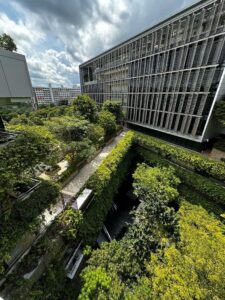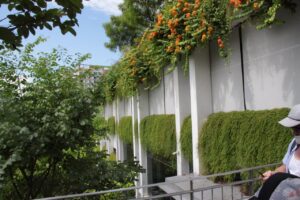Global perspectives on cultivating natural cities
By Michael Casey
Efforts in contemporary urban greening projects pave the way for a more sustainable future.
Embarking on a journey towards a harmonious coexistence with nature, we witness the transformative embrace of urban green projects worldwide. From the heart of a bustling metropolis to the soulful corners of quaint towns, communities are breathing life into concrete landscapes. Let’s delve into the diverse approaches employed globally, showcasing communities that are fostering a more profound connection with nature to create vibrant, resilient, and ecologically balanced urban environments.
In Singapore, the realisation of nature-based cities has become a remarkable testament to the transformative power of integrating greenery into urban landscapes. The city/state’s commitment to turning itself into a “City in a Garden” goes beyond mere rhetoric. Singapore’s Sky Parks, such as the iconic Gardens by the Bay, showcase the architectural marvels of incorporating lush greenery into the heart of the urban sprawl. Gardens by the Bay is a sprawling 101ha park that combines cutting edge architecture with sustainable practices. Its Supertree Grove, a collection of towering tree-like structures, not only serves as a visual spectacle but also functions as vertical gardens. These structures are embedded with photovoltaic cells, harvesting solar energy to illuminate the gardens at night. Additionally, the Flower Dome and Cloud Forest conservatories house a myriad of plant species, creating miniature ecosystems within the city.
In Copenhagen, Denmark, the concept of nature-based cities takes a different form, emphasising the importance of water in urban planning. The city’s commitment to sustainability and resilience is evident in its approach to climate change adaptation, demonstrated in their 2025 Climate Plan. The city’s main objective in this plan is to be the world’s first CO2-free capital/metropolis by 2025. The city boasts projects such as Copenhagen’s Cloudburst Management Plan which focuses on creating green infrastructure to manage excess rainwater, reducing the risk of flooding while enhancing the city’s green spaces. One striking example is the transformation of the Nørrebro district. Instead of relying solely on traditional concrete infrastructure, the district now features swales, green roofs, and permeable surfaces. These innovations not only mitigate flooding but also contribute to the overall well-being of the community. Citizens can enjoy recreational spaces that double as water management solutions, exemplifying the synergy between urban planning, nature, and climate resilience.

Moving to Melbourne, Australia, the city’s Greening the West initiative is a testament to the transformative power of community involvement in creating nature-based cities and suburbs. This collaborative project aims to enhance urban greenery and biodiversity in the western suburbs of Melbourne. Through extensive tree planting, creation of green corridors, and community engagement programs, Melbourne is fostering a sense of ownership among its residents for the green spaces around them.
The City of Melbourne is also working towards a greener city with roof garden projects, urban forests and the exciting Green Your Laneway projects which combine initiatives led by City of Melbourne, residents, landlords and businesses to create a whole range of laneway greening using a variety of different watering systems including green facades, green living wall systems, drain gardens and planters.
In the heart of North America, Chicago stands out as a pioneer in retrofitting its urban landscape to embrace nature. The Chicago Riverwalk project is a shining example of transforming industrial spaces into vibrant, ecologically sensitive areas. What was once a neglected stretch along the Chicago River is now a thriving promenade adorned with green spaces, public art, and recreational opportunities. The Riverwalk incorporates floating gardens that not only beautify the area but also enhance water quality by providing habitat for fish and other aquatic species. This transformation is not merely cosmetic; it represents a fundamental shift in how urban spaces can coexist with nature, creating spaces that invite both residents and visitors to engage with the environment.
Not stopping there, North America has embraced urban farming and this is evident in the transformation of abandoned lots, parks, rooftops, and even hospitals. With a growing desire among people to trace the origins of their food, community leaders nationwide are exploring innovative methods to cultivate fresh produce for their city’s residents. Urban agriculture goes beyond offering locally sourced food; it stimulates economic growth, reduces carbon emissions, and addresses various challenges related to environmental degradation, public health, poverty, and more. By empowering individuals with greater control over the food system, urban farming becomes a multifaceted solution.
Turning our attention to Asia, Tokyo, Japan, is exploring innovative solutions to maximise limited urban space for nature. The city’s vertical farming initiatives, such as the Pasona O2 building, demonstrate how agriculture can be integrated into the fabric of high-density urban environments. Pasona O2 features floors dedicated to cultivating a variety of crops, from rice paddies to orchards, within the building itself. Beyond its agricultural function, the Pasona O2 building serves as a green oasis in the heart of Tokyo, providing a breath of fresh air amid the bustling cityscape. Tokyo’s embrace of vertical farming not only addresses food security concerns but also showcases the potential for harmonising agriculture with urban living.

As we cross continents, Bogotá, Colombia, stands out as a city that prioritises the well-being of its citizens through the creation of extensive green spaces. The Ciclovía initiative, where major roads are temporarily closed to vehicular traffic, opening it up for use by pedestrians and cyclists, transforms the city into a network of interconnected parks. This not only promotes physical activity but also fosters a sense of community and connection with nature. Bogotá’s commitment to biodiversity is evident in its vast urban parks, such as Simón Bolívar Metropolitan Park. The park not only provides recreational spaces but also serves as a refuge for diverse flora and fauna. By embracing the philosophy that green spaces are essential for the holistic well-being of its citizens, Bogotá sets an example for other cities striving to become more nature centric.
Cape Town, South Africa, grapples with water scarcity challenges, highlighting the importance of sustainable water management in nature-based cities. The city’s “Water Resilience Plan” emphasises the need for decentralised water solutions, including rainwater harvesting, stormwater management, and wastewater recycling. Cape Town’s commitment to water-sensitive urban design is evident in projects like the Green Streets initiative. This endeavour transforms paved streets into permeable surfaces, allowing rainwater to replenish groundwater and support urban vegetation. The city’s approach demonstrates that, even in arid regions, nature-based solutions can play a crucial role in creating resilient and sustainable urban environments.
Further east, the city of Pune in India is reimagining urban spaces with an emphasis on community participation and green initiatives. Pune’s Tree Ambulance, a unique project, focuses on rescuing and rehabilitating trees that are affected by construction or development activities. This grassroots effort not only helps preserve the city’s green cover but also fosters a sense of responsibility among citizens towards their natural surroundings. Baner-Pashan Biodiversity Park is another noteworthy example. Originally a garbage dump, this area has been transformed into a thriving ecosystem with native vegetation, bird species, and small mammals. The park serves as a testament to the resilience of nature when given the opportunity to reclaim urban spaces.
In Latin America, Medellín, Colombia, stands out as a city that has successfully integrated social inclusion with nature-based urban development. The city’s transformation from a notorious crime hub to an innovative urban centre includes projects like the Biblioteca España, a library that spans a hillside and incorporates green spaces, providing not only a cultural hub but also a connection to nature for its residents. Medellín’s commitment to inclusivity is evident in projects like the Orquideorama, an orchid exhibit space within the city’s botanical garden. This architectural marvel not only showcases Colombia’s rich biodiversity but also serves as a public space for events, emphasising the role of nature in fostering community engagement and social cohesion.
As we conclude this exploration around the world, it’s clear that nature-based cities are not confined to a specific geographic region. From the futuristic landscapes of Singapore to the resilience initiatives in Cape Town, and from community-driven projects in Melbourne to social inclusion in Medellín, cities globally are embracing the transformative power of nature and more importantly, the power of plants. These cities are pioneers in redefining the relationship between urban spaces and the natural world. The future of nature-based cities lies not just in replicating these examples but in adapting and innovating new ideas based on local contexts, all while fostering a global movement towards urban environments that thrive in harmony with nature.
Michael Casey,
Director of Evergreen Infrastructure, Consultant/Advisor to the green infrastructure industry
On the Technical Panel for the AIPH World Green Cities Awards 2024
E: michael@evergreeninfrastructure.com.au

